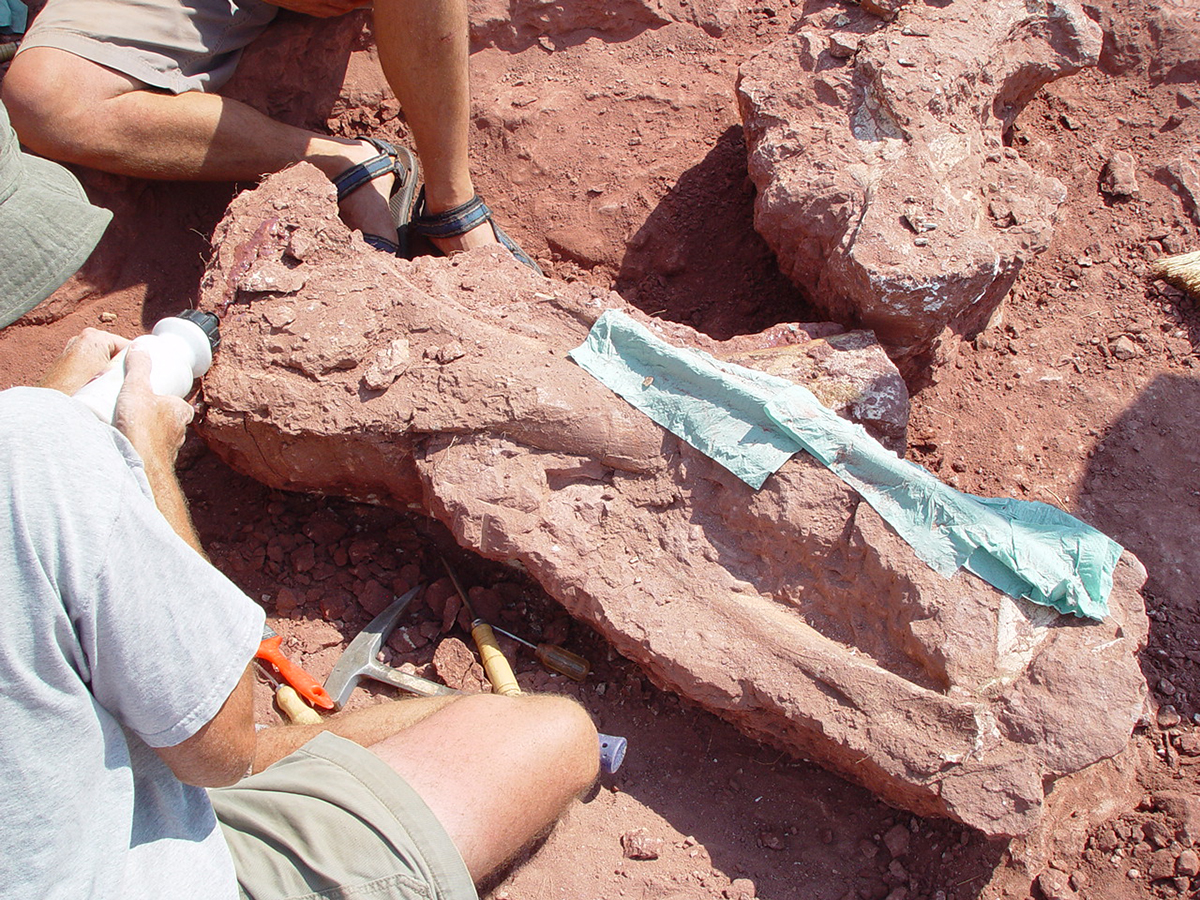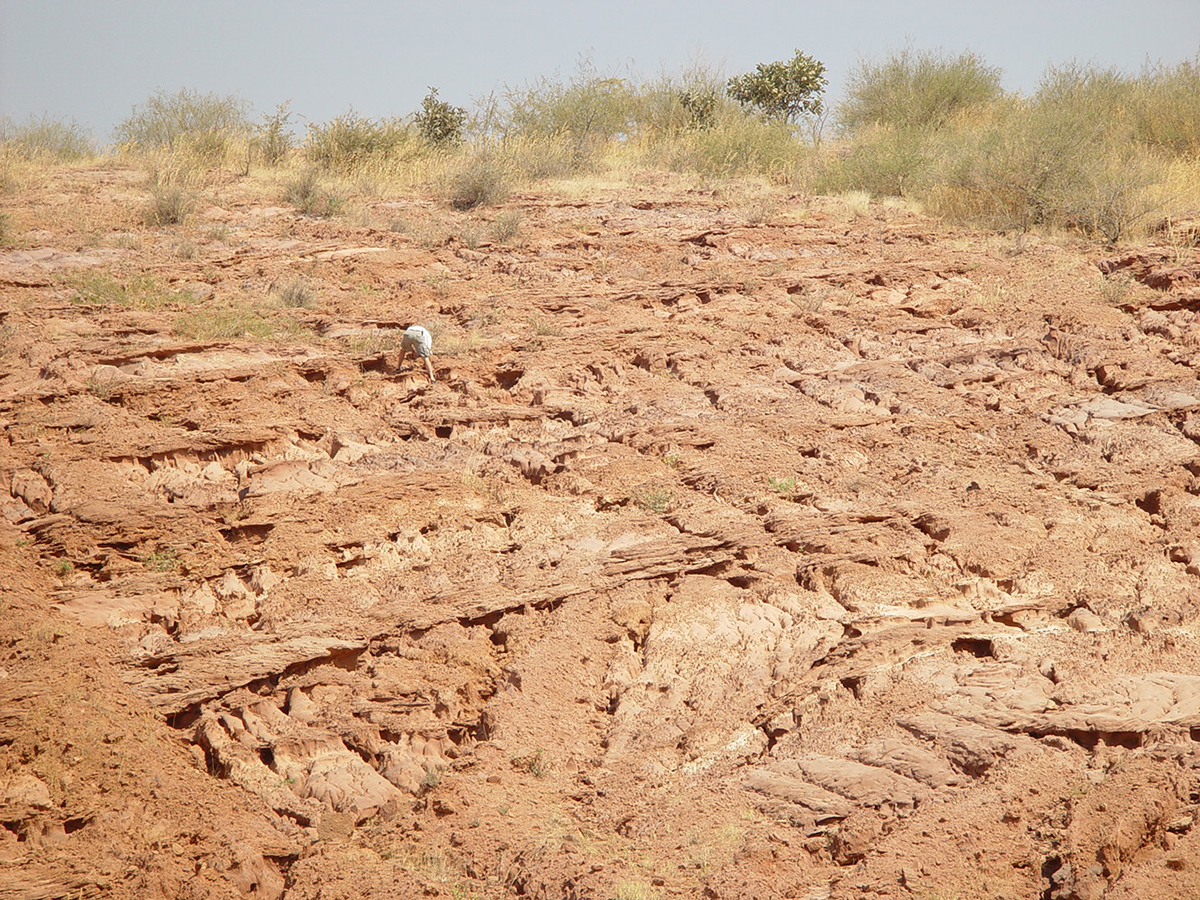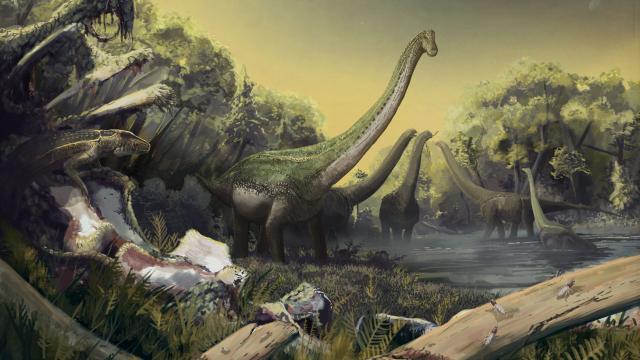During the Cretaceous Era some 70 to 100 million years ago, long-necked sauropods ruled the Earth. But in Africa, not so much. The discovery of a previously-unknown species of titanosaur in Tanzania expands what we know about dinosaurs on this continent, while revealing the surprising degree to which these creatures were related to similar dinos living in other parts of the world.
Image Credit: Mark Witton
Introducing Shingopana songwensis, a name that means “wide necked” in Swahili. The newly-described titanosaur’s neck vertebrae, ribs, humerus, lower jaw and other preserved bones were recently excavated in the Songwe region of the Great Rift Valley in southwestern Tanzania. A team led by Eric Gorscak from Chicago’s Field Museum of Natural History has completed its analysis of the fossils, the details of which now appear in Journal of Vertebrate Paleontology.
Here’s what we know about this new titanosaur: Shingopana‘s forelimb was about 1.5m tall. It weighed somewhere between 3.5 and 4.5 tonnes, which, for a titanosaur, is on the smaller end of the scale. For comparison, the contemporaneous titanosaur Rukwatitan, discovered back in 2014 in the same rock formation, weighed about 7 to 9 tonnes.

Excavation of Shingopana songwensis showing ribs and other bones being prepared for plaster-jacketing. (Image: Nancy Stevens)
Apart from its size, Shingopana differed from other African titanosaurs by virtue of a unique bulbous protrusion on the upper part of its cervical vertebrae. It also has some “supporting struts” on its spine that aren’t seen in other titanosaurs.
But the most interesting thing about Shingopana isn’t its size or its funky neck — what makes this discovery so special is rarity of the find, and how this particular species can be linked to sauropods that lived elsewhere during the Cretaceous.
Bones of titanosaurians have been found around the world, the vast majority in South America (including the newly-named Patagotitan mayorum — the largest animal to have ever stomped on land). Well over 30 titanosaurians have been uncovered in South America, compared with just six in Africa. Weirdly, Shingopana seems to have had more in common with titanosaurs living in South America than it did to those living in Africa.

So you wanna be a dinosaur hunter? A wide shot of the southwestern Tanzania locality from which the new dinosaur was excavated. (Image: Eric Roberts)
“According to both comparative morphology [that is, physical comparisons] and our phylogenetic analyses that reconstruct the titanosaurian family tree, Shingopana is more closely related to a small group of Late Cretaceous South American titanosaurians than with any other known titanosaurians from Africa, including Rukwatitan from the same rock unit,” Gorscak told Gizmodo. “In other words, Shingopana had siblings on South America and only distant cousins with those on Africa.”
A quick historical geography lesson explains how this happened.

Credit: Caltech
During the Cretaceous, Madagascar and Antarctica peeled away from Africa, drifting east and south respectively. This separation was soon followed by the uncoupling of South America. For a while, Northern Africa was connected to South America by a land bridge, but these continents were finally and irrevocably separated about 95 to 105 million years ago. Sauropod populations caught in this geological divorce became physically separated, spawning new evolutionary trajectories. The terrain and climate of these now-separated land masses dictated where the dinos would live, and how they would transition into new, but related, species.
“[The discovery] of Shingopana indicates that African titanosaurians, and by proxy the terrestrial [animals] of Cretaceous Africa, were likely more diverse than previously recognised due to the comparatively less-known Cretaceous fossil record of Africa with surrounding landmasses,” said Gorscak. “Additionally, given the close relationship with South American titanosaurians, Shingopana indicates that the two continents maintained some faunal affinities [that is, they shared many types of the same animals] up until the two landmasses finally separated from one another around 100 million years ago.”
As a final interesting note, the bones of Shingopana showed signs of strange damage that was inflicted soon after the animal died. An investigation by study co-author Eric Roberts of James Cook University in Australia revealed the source: Bone-boring insects. As Roberts pointed out in a release, the “presence of bone-borings provides a CSI-like opportunity to study the skeleton and reconstruct the timing of death and burial, and offers rare evidence of ancient insects and complex food webs during the age of the dinosaurs”.
It’s truly incredible what palaeontologists are able to figure out these days.
As a final final note, this work was partly funded by the US National Science Foundation, so cheers to America’s tax dollars being put to good use.
